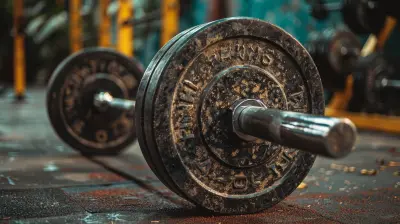16 March 2025
Running, for many, is the ultimate form of exercise. There’s something almost magical about feeling the breeze on your face and the rhythmic pounding of your feet on the pavement. You lace up your shoes, hit the road, and just go. It’s that simple, right? Well, not exactly. While running is a fantastic way to boost cardiovascular health and burn calories, many runners overlook one crucial aspect of their training: strength training. Yep, those dumbbells aren't just for bodybuilders.
If you're a runner and you're not incorporating strength exercises into your routine, you're missing out on some serious gains. Strength training for runners is not just a "nice-to-have"—it’s a game changer. Let’s dive into the why, the how, and the what of strength training for runners.

Why Every Runner Needs Strength Training
1. Improved Running Efficiency
Let’s break it down. Running is essentially a series of repetitive movements. Over time, if certain muscles are weak or underdeveloped, other muscles have to compensate. This can lead to poor form and inefficiency. Think of your body like a car. If one tire is flat, the other tires have to work harder to keep the car moving. The same goes for your muscles.When you strengthen key muscles, like your glutes, quads, hamstrings, and core, your body becomes more balanced and efficient. This means less energy is wasted with every step. In turn, you can run faster, longer, and with better form. Who doesn’t want that?
2. Injury Prevention
Let’s be real—getting injured sucks. One minute you're crushing your personal best, and the next, you're sidelined with a nagging knee injury or tight calf muscles. A lot of common running injuries (think runner’s knee, IT band syndrome, or Achilles tendonitis) can be traced back to muscular imbalances or weaknesses.By integrating strength work, you’re fortifying your muscles, tendons, and ligaments, making them resilient to the repetitive stress that running places on your body. You’re essentially bulletproofing yourself against injury. It’s like adding extra armor to your body, making it less prone to wear and tear.
3. Enhanced Speed and Power
Want to run faster? Of course, you do. While running more miles or doing speed work can help, strength training is the secret sauce that often gets overlooked. Strength training builds explosive power, particularly in your legs. This power translates to faster sprints and an improved ability to push off the ground with every stride.Think about it like this: If you’re trying to run with weak legs, it’s like trying to drive a car with a weak engine. Strength training revs up that engine, giving you more horsepower to leave your competition in the dust.
4. Better Endurance
Runners are always chasing that elusive “second wind.” But what if I told you that strength training could give you a third, fourth, or even fifth wind? When your muscles are stronger, they’re better able to withstand the fatigue that sets in during long runs. You'll find that you can maintain your speed and form even when you're several miles deep into a race. Instead of dragging your feet through those final miles, you'll still have enough gas left in the tank to finish strong.
How to Incorporate Strength Training Into Your Running Routine
Okay, so now that you’re sold on the benefits, you’re probably wondering: “How do I actually fit this into my already packed running schedule?” Don’t worry—it doesn’t have to be complicated or time-consuming.1. Start Small
If strength training is new to you, don’t feel like you need to spend hours in the gym. Start with just two days per week, focusing on the major muscle groups that runners rely on the most: legs, core, and glutes. You can even incorporate bodyweight exercises if you’re not ready to pick up the dumbbells just yet.2. Focus on Compound Movements
Compound exercises are your best friend. These are movements that work multiple muscle groups at once, like squats, lunges, deadlifts, and push-ups. The beauty of compound exercises is that they give you more bang for your buck—meaning you can build strength in several areas at once, which is perfect for time-crunched runners.3. Don’t Neglect Your Core
A strong core is the foundation of good running form. When your core is weak, your posture suffers, and you become more prone to injuries like lower back pain. Exercises like planks, Russian twists, and leg raises can work wonders for stabilizing your core and improving your overall running mechanics.4. Balance Strength Training With Running
It’s crucial to find a balance between your running and strength training. You don’t want to lift heavy weights the day before a long run—you’ll be too sore and fatigued to perform at your best. Instead, schedule your strength sessions on your easy run or rest days. This way, you’re giving your body time to recover before your next big run.5. Recovery is Key
Here’s the thing: Strength training can make you sore, especially in the beginning. That’s totally normal. But it’s important to listen to your body and allow it to recover. Make sure you’re incorporating rest days, stretching, and foam rolling into your routine to prevent overtraining and burnout.
What Strength Training Exercises Should Runners Do?
Now comes the fun part—choosing the exercises that will make you a better runner. Below are some highly effective strength training exercises for runners:1. Squats
Squats are the king of all leg exercises. They target your quads, hamstrings, glutes, and even your core. You can start with bodyweight squats and progress to weighted squats as you get stronger. Squats improve leg power and stability, which is essential for strong running form.How to Do It:
Stand with your feet shoulder-width apart. Lower down as if you’re sitting in a chair, keeping your chest up and your knees behind your toes. Push through your heels to return to the starting position.
2. Lunges
Lunges are fantastic for building single-leg strength, which is crucial since running is essentially a single-leg activity. They also target the glutes, quads, and hamstrings.How to Do It:
Step forward with one leg, lowering your hips until both knees are bent at about a 90-degree angle. Push back up to the starting position and repeat on the other leg.
3. Deadlifts
Deadlifts strengthen the entire posterior chain (the muscles along the back of your body), including the hamstrings, glutes, and lower back. These muscles are often neglected in runners, so deadlifts can help correct imbalances.How to Do It:
Stand with your feet hip-width apart, and hold a weight in front of your thighs. Hinge at your hips to lower the weight toward the ground, keeping your back flat. Return to the standing position by driving through your heels and squeezing your glutes.
4. Planks
A strong core is key for maintaining good posture and avoiding injuries during long runs, and planks are one of the best exercises to strengthen it.How to Do It:
Start in a push-up position, but rest on your forearms instead of your hands. Keep your body in a straight line from your head to your heels. Hold this position for as long as you can, aiming for 30–60 seconds.
5. Glute Bridges
Strong glutes are essential for runners, as they help propel you forward and stabilize your hips. Glute bridges are a simple yet effective way to activate and strengthen those muscles.How to Do It:
Lie on your back with your knees bent and feet flat on the ground. Lift your hips toward the ceiling, squeezing your glutes at the top. Lower back down and repeat.
6. Step-Ups
Step-ups mimic the running motion and help build single-leg strength, stability, and balance. They’re also great for improving knee and hip mobility.How to Do It:
Find a sturdy bench or box. Step up with one leg, driving through your heel to lift yourself up. Step back down and repeat on the other leg.

The Mental Benefits of Strength Training for Runners
We’ve talked a lot about the physical benefits, but there’s another side to this: the mental game. Running is as much a mental battle as it is a physical one. The stronger you feel, the more confident you become. Strength training builds mental toughness. It teaches you to push through discomfort, challenge your limits, and stay focused. All of these skills translate directly to running—whether you're powering through a tough hill or pushing for a PR in your next race.Conclusion
So, there you have it. Strength training for runners is a game changer, plain and simple. It improves running efficiency, prevents injuries, boosts speed and power, and even enhances endurance. By incorporating just a couple of strength sessions into your weekly routine, you can unlock a whole new level of performance. Whether you’re a seasoned marathoner or a casual jogger, strength training is the secret weapon you didn’t know you needed.Next time you lace up your running shoes, don’t forget to hit the weights, too. Your body—and your race times—will thank you.











Roxie Miller
Strength training elevates runners to new heights!
April 8, 2025 at 12:56 PM